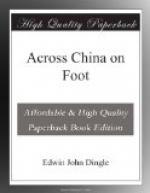Travel up the Salwen Valley. My motive for travelling and how I travel. Valley not a death-trap. Meet the Li-su. Buddhistic beliefs. Late Mr. G. Litton as a traveler. Resemblance in religion to Kachins. Ghost of ancestral spirits. Li-su graves. Description of the people. Racial differences. John the Baptist’s hardship. The cross-bow and author’s previous experience. Plans for subsequent travel fall through. Mission work among the Li-su.
On my return journey into Yuen-nan, I stopped at Lu-chiang-pa,[BB] and left my men at the inn there while I traveled for two days along the Salwen Valley. My journey was taken with no other motive than that of seeing the country, and also to test the accuracy of the reports respecting the general unhealthy nature of this valley of the Shadow of Death. The people here were friendly, despite the fact that my route was always far away from the main road; and although my entire kit was a single traveling-rug for the nights, I was able to get all I wanted. Lao Chang accompanied me, and together we had an excellent time.
I might as well say first of all that the idea of this part of the Salwen Valley being what people say it is in the matter of a death-trap is absolutely false. With the exception of the early morning mist common in every low-lying region in hot countries, there was, so far as I could see, nothing to fear.
During the second day, through beautiful country in beautiful weather, I came across some people who I presumed were Li-su, and I regretted that my films had all been exposed. The Li-su tribe is undoubtedly an offshoot from the people who inhabit south-eastern Tibet, although none of them anywhere in Yuen-nan—and they are found in many places in central and eastern Yuen-nan—bear any traces of Buddhistic belief, which is universal, of course, in Tibet. The late Mr. G. Litton, who at the time he was acting as British Consul at Tengyueh traveled somewhat extensively among them, says that their religious practices closely resemble those of the Kachins, who believe in numerous “nats” or spirits which cause various calamities, such as failure of crops and physical ailments, unless propitiated in a suitable manner. According to him, the most important spirit is the ancestral ghost. Li-su graves are generally in the fields near the villages, and over them is put the cross-bow, rice-bags and other articles used by the deceased. “It is probably from foundations such as these,” writes Mr. George Forrest, who accompanied Mr. Litton on an excursion to the Upper Salwen, and who wrote up the journey after the death of his companion, “that the fabric of Chinese ancestor worship was constructed,” a view which I doubt very much indeed.




